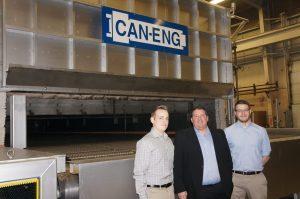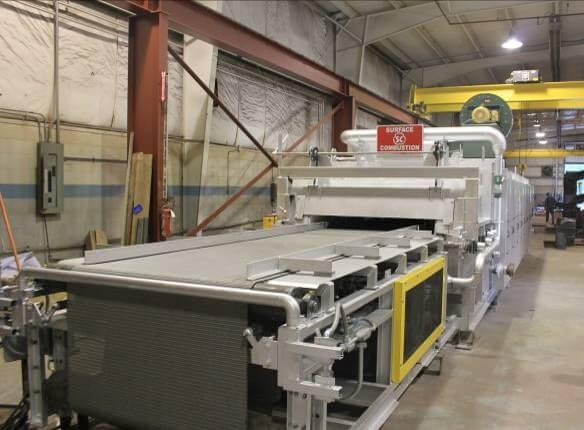Captive Heat Treater Closes Down-Throws Heat Treat Furnaces on the Used Market
Back in early 2020 it was announced by the Timken Company that their recently acquired Diamond Chain Company division in Indianapolis, Indiana, USA would be permanently closed by 2023 with operations moving to other Timken facilities; “FEBRUARY 4, 2020. The 102-year-old Diamond Chain Company facility in downtown Indianapolis and its 240 employees will leave the city for good in two to three years as company officials look to consolidate operations in Illinois. Officials from The Timken Company, which acquired Diamond Chain from Amsted Industries in April 2019, notified associates at the Indianapolis plant of the closure and relocation on Tuesday. Timken Spokesperson Scott Schroeder said the facility in Fulton, Illinois, will be established as the global chain business headquarters over the next 24 to 36 months. “Since acquiring Diamond Chain last year, we’ve been carefully evaluating how to best integrate the business,” Schroeder told IndyStar via email. “Our lease is expiring in Indianapolis; relocating to Fulton, where we own the facility, allows us to leverage our existing manufacturing footprint to best serve our customers.”
The closure did indeed happen and the end result is that all of the equipment is going to auction early in 2023. As always the interest of “The Monty Heat Treat News” begins and ends with the heat treatment aspect. Diamond Chain had a respectable in house heat treatment department with the center piece being 4 Surface Combustion mesh belt furnace lines. Recently we had an article about how large capacity mesh belt lines are very hard to find and generally never make it to the used market-unfortunately in the case of Diamond Chain, these are not large capacity furnaces, they are older and they were built by Surface Combustion who is one of the smaller players in the mesh belt furnace industry. Still we would expect these furnaces will find a home and we will try and tell you where that home is.
We leave you with this article published August 30/2022 by “The Monty Heat Treat News” in which Tim Donofrio, VP of Sales for Can Eng Furnaces talks about the history of mesh belt furnaces in North America and how over the years the capacity has become larger and larger.
“What’s Hot on the Used Heat Treat Furnace Market-Mesh Belt Furnace Lines” By Tim Donofrio of Can Eng Furnaces
“Your recent posting regarding Mesh Belt Furnaces and CAN-ENG Furnaces contributions to these technologies was presented well and I can confirm that decent larger capacity used Mesh Belt Furnaces are as common as unicorn sightings.
 My 25 years’ experience with CAN-ENG, has shown that systems with capacities greater than 3000 Lbs/hr simply do not go to the open market and in fact if available are transferred inter-company, moved outside of the user’s local geography, or disposed of for competitive reasons. Over the years, CAN-ENG has supported several new mesh users who successfully located these systems for export into new growing markets. In most cases, surplus equipment was made available because the user wanted to upgrade their existing Mesh Belt Heat Treatment System for more Efficient and Higher Capacity lines. In the earlier days, CAN-ENG Furnaces Large Capacity Mesh Belt lines were 3000-4000 lbs/hr. Today large capacity lines are 6000-7300 lbs./hr. As you can imagine if the volumes warrant, users can significantly reduce their costs via economies of scale processing one line versus multiple smaller lines.
My 25 years’ experience with CAN-ENG, has shown that systems with capacities greater than 3000 Lbs/hr simply do not go to the open market and in fact if available are transferred inter-company, moved outside of the user’s local geography, or disposed of for competitive reasons. Over the years, CAN-ENG has supported several new mesh users who successfully located these systems for export into new growing markets. In most cases, surplus equipment was made available because the user wanted to upgrade their existing Mesh Belt Heat Treatment System for more Efficient and Higher Capacity lines. In the earlier days, CAN-ENG Furnaces Large Capacity Mesh Belt lines were 3000-4000 lbs/hr. Today large capacity lines are 6000-7300 lbs./hr. As you can imagine if the volumes warrant, users can significantly reduce their costs via economies of scale processing one line versus multiple smaller lines.
 Further to this, I thought your readers would enjoy learning more about the evolution of CAN-ENG Furnaces Mesh Belt Heat Treatment Technology. CAN-ENG has and continues today to be a technology focused company. To that end in the mid-1980s, John Kay and Wally Bamford recognized the opportunity that Continuous Mesh Belt Furnace Systems offered to North American manufacturers, and they pursued it. As a result of a detailed global technology review, an agreement between CAN-ENG and Kanto Yakin Kogyo Company Limited (KYK) of Japan was developed. KYK was to provide their larger capacity mesh belt design expertise and CAN-ENG was to build and commissioned the equipment for the local marketplace. Following this agreement in 1988, CAN-ENG was successful in securing four separate orders and successfully blended its own expertise with KYK’s furnace technology to build a hybrid Continuous Mesh Belt Furnace System for the North American fastener and small product production market. These customers included B&W Heat Treatment (Bluewater), Thermo Treat (Bodycote), Metallurgical Services and Wrought Washer. This was the beginning of large capacity mesh belt furnace technology development for carburizing and/or hardening, these earlier furnace designs used a unique herringbone pattern skid-type hearth to improve mesh belt tracking and eliminate wandering and reduction in part drop heights that prevent the intermixing and part damage potential.
Further to this, I thought your readers would enjoy learning more about the evolution of CAN-ENG Furnaces Mesh Belt Heat Treatment Technology. CAN-ENG has and continues today to be a technology focused company. To that end in the mid-1980s, John Kay and Wally Bamford recognized the opportunity that Continuous Mesh Belt Furnace Systems offered to North American manufacturers, and they pursued it. As a result of a detailed global technology review, an agreement between CAN-ENG and Kanto Yakin Kogyo Company Limited (KYK) of Japan was developed. KYK was to provide their larger capacity mesh belt design expertise and CAN-ENG was to build and commissioned the equipment for the local marketplace. Following this agreement in 1988, CAN-ENG was successful in securing four separate orders and successfully blended its own expertise with KYK’s furnace technology to build a hybrid Continuous Mesh Belt Furnace System for the North American fastener and small product production market. These customers included B&W Heat Treatment (Bluewater), Thermo Treat (Bodycote), Metallurgical Services and Wrought Washer. This was the beginning of large capacity mesh belt furnace technology development for carburizing and/or hardening, these earlier furnace designs used a unique herringbone pattern skid-type hearth to improve mesh belt tracking and eliminate wandering and reduction in part drop heights that prevent the intermixing and part damage potential.
As the equipment designs matured so did the advancements in designs and capacities. CAN-ENG has always been a company with engineers at its core. Customers’ needs drove designs forward. Feedback from customers, enhanced servicing in the field with improved access and combustion designs. CAN-ENG’s Continuous Mesh Belt Atmosphere Furnace became more robust, more energy efficient and easier to maintain. The struggle for industry dominance was being won and CAN-ENG became the North American leader for this industrial furnace. The following thirty years has provided CAN-ENG the opportunity to continue to modify the CAN-ENG Mesh Belt (CEMB) design, building larger equipment for commercial fastener manufacturers, automotive and stamping industries and Austemper and Martempering processors. I included an advertisement that dates to the early 1990s that I thought you would find interesting.” Tim Donofrio, Vice President Sales at Can-Eng Furnaces International, Ltd
Did you like this article? Click here to subscribe to The Monty.
View our recent magazines and podcasts by clicking the following link. https://themonty.com/magazine/
typical new Surface Combustion Mesh Belt Furnace Line

